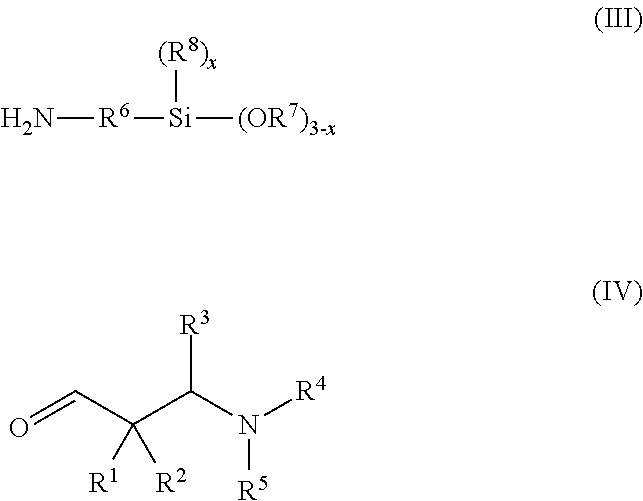Secondary aminosilanes
a technology of aminosilane and aminosilane, which is applied in the field of secondary amines, can solve the problems of difficult processing of silane functional polymers, negative effect on the adhesion of cured compositions, and unsatisfactory moisture absorption properties
- Summary
- Abstract
- Description
- Claims
- Application Information
AI Technical Summary
Benefits of technology
Problems solved by technology
Method used
Image
Examples
example 1
Iminosilane I-1
3-(2,2-dimethyl-3-(N-morpholino)propylideneamino)propyltrimethoxysilane
[0257]17.98 g 2,2-dimethyl-3-(N-morpholino)propanal, 7.45 g 2-propanamine and 17.93 g 3-aminopropyltrimethoxysilane were reacted according to the general manufacturing procedure (iminosilanes). Yield: 32.2 g of a clear, yellowish oil with an amine content of 9.29 mmol N / g and a purity of 92%.
[0258]FT-IR: 2955, 2938, 2920 sh, 2837, 2809 sh, 1664 (vC═N), 1454, 1410, 1396, 1375, 1360, 1345 sh, 1318, 1303, 1282, 1267, 1189, 1135, 1116, 1080, 1036, 1012, 930, 864, 815, 801, 775, 677.
[0259]1H-NMR (CDCl3, 300 K): δ 7.54 (t, J=1.2, 1H, CH═N), 3.64 (t, J=4.7, 4H, OCH2CH2N), 3.57 (s, 9H, Si(OCH3)3), 3.35 (t×d, J=7.0 / 1.1, 2H, CH═NCH2), 2.46 (t, J=4.7, 4H, OCH2CH2N), 2.34 (s, 2H, NCH2C(CH3)2), 1.68 (m, 2H, CH═NCH2CH2CH2Si), 1.06 (s, 6H, C(CH3)2), 0.60 (m, 2H, CH═NCH2CH2CH2Si).
example 2
Iminosilane I-2
3-(2,2-dimethyl-3-(N,N-dimethylamino)propylideneamino)propyltrimethoxysilane
[0260]13.57 g 2,2-dimethyl-3-dimethylaminopropanal, 7.45 g 2-propanamine and 17.93 g 3-aminopropyltrimethoxysilane were reacted according to the general manufacturing procedure (iminosilanes). The product was distilled after manufacture in order to remove oligomer portions. Yield: 28.4 g of a clear, colorless oil having an amine content of 6.61 mmol N / g and a purity of 95%.
[0261]FT-IR: 2938, 2837, 2828, 2766, 1665 (vC═N), 1455, 1411, 1388, 1363, 1342, 1301, 1264, 1189, 1082, 1042, 906, 872, 844, 814, 775, 676.
[0262]1H-NMR (CDCl3, 300 K): δ 7.57 (t, J=1.2, 1H, CH═N), 3.56 (s, 9H, Si(OCH3)3), 3.37 (t×d, J=7.0 / 1.2, 2H, CH═NCH2), 2.32 (s, 2H, NCH2C(CH3)2), 2.23 (s, 6H, N(CH3)2), 1.69 (m, 2H, CH═NCH2CH2CH2Si), 1.07 (s, 6H, C(CH3)2), 0.62 (m, 2H, CH═NCH2CH2CH2Si).
example 3
Iminosilane I-3
3-(2,2-Dimethyl-3-(N,N-dimethylamino)propylideneamino)propyltriethoxysilane
[0263]13.57 g 2,2-dimethyl-3-dimethylaminopropanal, 7.45 g 2-propanamine and 22.14 g 3-aminopropyltriethoxysilane were reacted according to the general manufacturing procedure (iminosilanes). Yield: 32.3 g of a clear, colorless oil having an amine content of 5.97 mmol N / g and a purity of 98%.
[0264]FT-IR: 2970, 2926, 2882, 2817, 2765, 1883 br, 1665 (vC═N), 1466 sh, 1454, 1442, 1410, 1389, 1364, 1341, 1296, 1264, 1250 sh, 1181 sh, 1165, 1101, 1075, 1042, 993, 954, 867, 845, 809 sh, 791 sh, 774, 678.
[0265]1H-NMR (CDCl3, 300 K): δ 7.57 (t, J=1.2, 1H, CH═N), 3.81 (q, J=7.0, 6H, Si(OCH2CH3)3), 3.37 (t×d, J=7.0 / 1.2, 2H, CH═NCH2), 2.32 (s, 2H, NCH2C(CH3)2), 2.23 (s, 6H, N(CH3)2), 1.70 (m, 2H, CH═NCH2CH2CH2Si), 1.22 (t, J=7.0, 9H, Si(OCH2CH3)3), 1.07 (s, 6H, C(CH3)2), 0.60 (m, 2H, CH═NCH2CH2CH2Si).
PUM
| Property | Measurement | Unit |
|---|---|---|
| temperature | aaaaa | aaaaa |
| temperature | aaaaa | aaaaa |
| pressure | aaaaa | aaaaa |
Abstract
Description
Claims
Application Information
 Login to View More
Login to View More - R&D
- Intellectual Property
- Life Sciences
- Materials
- Tech Scout
- Unparalleled Data Quality
- Higher Quality Content
- 60% Fewer Hallucinations
Browse by: Latest US Patents, China's latest patents, Technical Efficacy Thesaurus, Application Domain, Technology Topic, Popular Technical Reports.
© 2025 PatSnap. All rights reserved.Legal|Privacy policy|Modern Slavery Act Transparency Statement|Sitemap|About US| Contact US: help@patsnap.com



